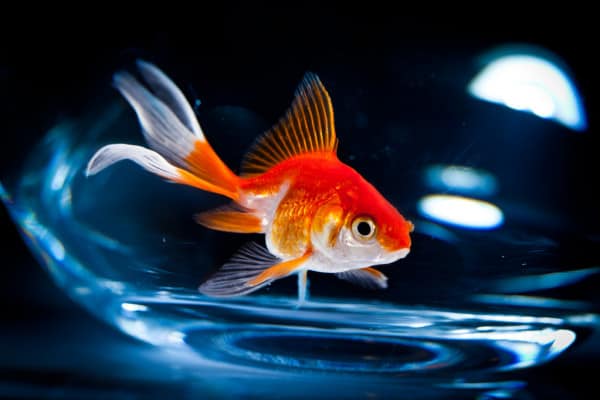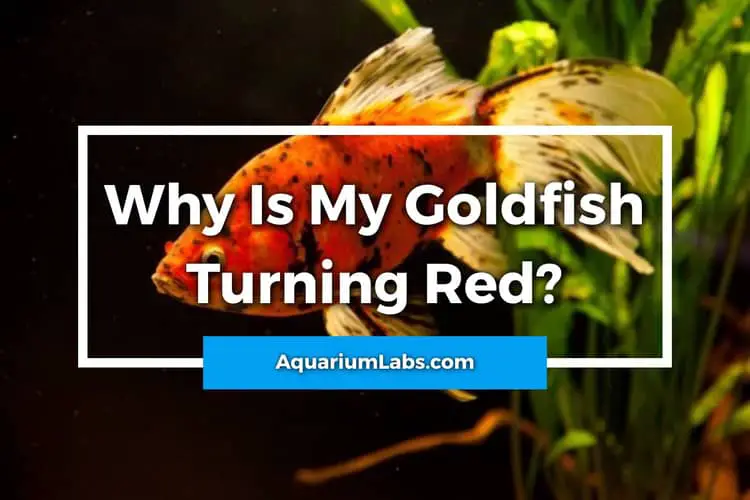Goldfish get their name from their metallic orange tones. But what if you start seeing patches of red developing on your fish? A goldfish that’s turning red is something to watch carefully because it can indicate a water quality or disease issue that needs your attention. So let’s take a look at the reasons why your goldfish is turning red – and how to treat these issues!
Sores From a Bacterial or Fungal Infection
The most common reasons why your fish is turning red are, unfortunately goldfish diseases. When kept in tanks with poor water quality, opportunistic diseases can take hold in a fish’s body. Infected fish develop red streaks in their fins and bloody patches on their flanks thanks to fungal or bacterial infections.
The bacterial form is a goldfish disease called red pest disease, while the fungal infection is known as fin rot or body fungus, depending on the infectious organism. The most common infectious agent is the bacterium Cyprinicida.
When poor water conditions weaken the immune system and allow germs to accumulate in your tank, opportunistic diseases can quickly become a problem for fish. You can even see a secondary infection like anchor worms or ich, which will cause most fish to eventually die. Fortunately, these diseases are some of the easiest to treat if caught early!

Treating a Fungal or Bacterial Infection
In order to treat these goldfish diseases, you’ll need to know which disease your fish has since medications don’t respond to them in the same ways. The symptoms of red pest (bacterial infection) include not only blood-red sores but clamped fins, excess body mucus, and cloudy eyes.
However, a fungal infection shows stringy patches of cottony growth growing from the red spots. Other symptoms include lethargy and scratching against the substrate or decorations. Since the cottony growths are transparent, body fungus can be harder to spot in a pond unless you catch the fish for a closer look.
You’ll need an antibiotic for a bacterial infection and an antifungal agent for a fungal one. But before treating the tank, you should immediately do a large water change to reduce your bacterial and ammonia levels. A water change will also remove fungal spores, which are resistant to medicines and can reinfect fish.
For red pest, antibiotics like Melafix, coupled with a light dose of aquarium salt, will stop the spread of the disease and help promote the healing process. For fungal infections, you can use methylene blue or Pimafix! It’s best to move a sick fish to a small hospital tank. This way, you can use less medication, perform daily water changes and prevent the other fish from getting infected.

Ammonia Poisoning
Of all the water parameters you want to keep track of using an aquarium test kit, ammonia levels are the most important. Elevated ammonia will first lead to black or blood red patches on a fish’s body, followed by red gills and gasping as ammonia poisoning takes hold. Eventually, your fish will die if you don’t improve the water quality.
Like other fish, goldfish produce ammonia as they excrete waste into the tank. Normally your nitrifying bacteria (good bacteria) consume this ammonia, converting it into less toxic byproducts through the nitrogen cycle. But if you have too many fish or overfeed, ammonia levels can get high enough to induce ammonia poisoning in your fish tank. Common goldfish diseases like bacterial infection (see above) are also an issue when there’s too much ammonia.
New tank syndrome is another way ammonia levels get elevated. New tank syndrome is caused by adding too many fish to a brand new tank. Since there are no nitrifying bacteria to process the ammonia they release, aquarium conditions quickly become toxic.
Treating Your Fish Tank for Ammonia Poisoning
Ammonia poisoning is quickly fatal if left untreated. So you should immediately perform water changes to remove the toxic compounds and freshen the tank with clean water. While using your gravel vacuum, siphon the bottom to remove feces, uneaten food, and other debris. All of this additional waste contains organic matter that feeds decay-causing bacteria, adding to your ammonia levels.
That said, prevention is always the best medicine. Keeping the tank clean with regular water changes and filter maintenance will ensure your fish don’t develop blood-red patches from poor water conditions.
Related: Best Filters for Goldfish
And feed less food; goldfish don’t have a fast metabolism, especially once they are fully grown. 1 or 2 feedings per day, enough that they will eat every crumb, is plenty for healthy adult fish!
Make sure you also keep a testing kit on hand to monitor water conditions daily until ammonia levels stabilize.
Nitrate Poisoning
Nitrate poisoning is less common than ammonia poisoning or bacterial infections, but it can still occur if you go too long between water changes. Nitrate is the least toxic of the waste compounds processed by your beneficial bacteria. Ammonia is quickly processed by bacteria into nitrite, which is less toxic but still fairly poisonous. Fortunately, a second set of bacteria then eat it, lowering your nitrate levels by converting it into nitrate. Nitrate is not great either, but it’s well tolerated by healthy fish. But if nitrate levels are allowed to get especially high (30+ ppm), even healthy fish can start to get sick.
Fish living with high nitrate levels will often show brown gills and gasp near the surface. This is because nitrate starts to interfere with the oxygen-carbon dioxide exchange function that hemoglobin provides (the red pigment in animal blood). Fish with nitrate poisoning will also start to become lethargic, swimming slowly, and losing their appetite for food. Your goldfish may also display clamped fins and signs of other infections like fin rot if nitrate levels remain elevated.
Treating Your Fish Tank for Nitrate Poisoning
NItrate poisoning is fortunately very easy to treat! Simply perform a few 50% water changes over the course of a few days. This will flush all of the nitrates from the system, helping your goldfish recover over time. Just make sure to match the water parameters as closely as possible when adding new tap water. Otherwise, you can stress and even shock your fish by performing several water changes where the water has a drastically different temperature or pH.
We need to do water changes because nitrate isn’t processed by nitrifying bacteria and simply accumulates in your aquarium until you remove it with a water change. If you don’t keep up with your water properly, your goldfish will eventually suffer from nitrate poisoning. There are actually de-nitrifying bacteria that can consume nitrate, converting it into nitrogen gas, which disappears into the air. But these bacteria need specialized anaerobic (oxygen-less) environments and aren’t found in high numbers in aquarium conditions.
Genetic Changes

The last reason why your goldfish is turning red might be due to simple genetic changes! Goldfish are infamous for changing their colors as they grow older, especially the black moor. These changes are unpredictable but harmless. They may reverse themselves, causing your fish to lose their red patches – or they may be permanent. So long as your fish appears healthy and you don’t see any other symptoms of illness, there’s little to worry about here!
Conclusion
The reasons why your goldfish is turning red are varied, ranging from diseases and water chemistry to simple genetic changes. But you should always take red patches as a sign to look carefully at your aquarium conditions, just to be sure! A healthy goldfish is normally stable in color and won’t show sudden changes in hue. Happy fish keeping!
Related Goldfish FAQs:

